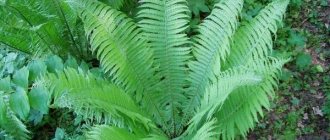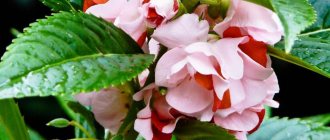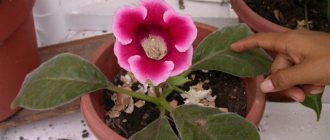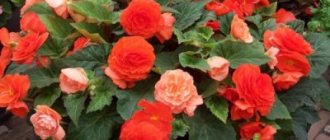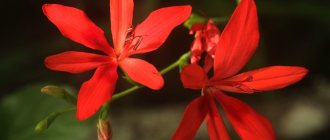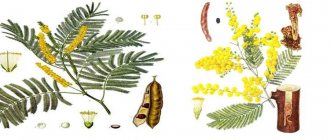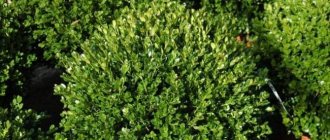Features of asparagus
Asparagus is represented by herbaceous plants, shrubs and vines, which are perennials. A characteristic feature of such a plant is that in most species the process of photosynthesis does not occur in the foliage. Asparagus flowers are unisexual and bisexual, while on the same bush on different branches you can find flowers of different sexes that are unisexual. The biological structure of asparagus flowers is the same as that of lilies, but instead of a bulb it has a rhizome. If you decide to grow asparagus, then remember that once its stems are cut, they will no longer be able to grow. It is from the rhizome that new parts of the shoot appear, since all of them are embedded in it even before growth begins. In this regard, after pruning, shoot growth stops.
How to care in winter?
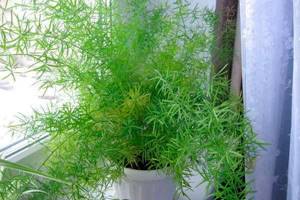
The dormant period for asparagus is a relative concept, since even in winter, while hibernating, it continues to grow a little.
In this regard, there is no need to completely stop fertilizing and watering the plant; you should simply reduce watering to once a week, and fertilizing to once a month .
The room should be bright and cool – the temperature should be approximately +15°C, minimum – +10°C.
Brief description of cultivation
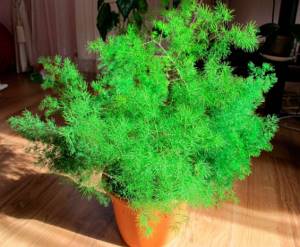
- Bloom . When grown at home, asparagus blooms very rarely.
- Illumination . A bright light is needed, which must be diffused.
- Temperature regime . In summer, no more than 25 degrees, and in winter, no more than 15 degrees.
- Watering . Asparagus is watered through a tray. During intensive growth, the substrate is moistened immediately after its top layer in the pot dries. In the autumn-winter period, the plant should be watered very sparingly, but the clod of earth in the pot should not be allowed to dry out.
- Air humidity . It should be elevated. On hot days, the bushes are moistened with a spray bottle in the morning and evening. Also, to increase humidity, you can pour wet moss, pebbles or expanded clay into the tray, and place a pot with a plant on top of it.
- Fertilizer . Feeding is carried out regularly: in the spring-summer period - once every 7 days, in the autumn - once every 15 days, and in winter - once every 30 days. To do this, use a mineral complex fertilizer for decorative deciduous plants, and the concentration of the ready-to-use nutrient solution should be weak.
- Rest period . It is not pronounced, but in winter the bush develops and grows very slowly.
- Trimming . Prune in early spring during transplantation.
- Transplant . Until the plant is 4 or 5 years old, it is subjected to this procedure regularly once a year, and older specimens are replanted once every 2 or 3 years.
- Soil mixture . It should consist of turf, leaf and humus soil, as well as sand (2: 2: 2: 1).
- Reproduction . By cuttings, dividing the bush and seed method.
- Harmful insects . Spider mites.
- Diseases . Due to improper care and unsuitable conditions, problems may begin with the plant.
- Properties . Asparagus fruit contains poison. However, under indoor conditions, flowering of such a plant is observed extremely rarely, but even if this happens, it still will not set fruit.
Asparagus. Care
Can a houseplant be grown outdoors?
You can grow asparagus not only at home, but also in open soil. To do this, you need to choose a well-lit place where there is no groundwater .
You need to plant seeds or young shoots of the plant in open ground in mid-spring.
When growing in open ground, it is necessary to regularly weed and also tie up shoots to prevent them from coming into contact with the soil.
Decorative indoor species look great in garden plots, but still the most suitable for growing in open ground are common asparagus (Asparagus officinalis) and edible asparagus (green asparagus).
Caring for asparagus at home
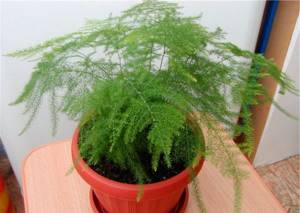
Illumination
To grow asparagus, choose a windowsill with an eastern or western orientation. The fact is that it needs bright sunlight, but the scorching direct rays of the sun should not fall on it. However, the rays of the morning or evening sun will not harm the plant. If a place for asparagus was found only in the southern room, then it should be placed away from the window. With the onset of May, you can begin to accustom the bush to fresh air, but this must be done gradually. And in the summer, it can be moved to the garden or to the balcony, but you need to choose a place for it that will be protected from precipitation, the scorching rays of the midday sun and drafts.
Temperature
Make sure that in the summer the asparagus is not exposed to heat for a long time (more than 25 degrees). The optimal temperature for it in spring and summer is from 22 to 24 degrees. If during the winter months the bush is in a room that is too warm (more than 15 degrees), then its leaves will begin to fly away, even if the air humidity is high. Dried shoots must be cut off.
Watering
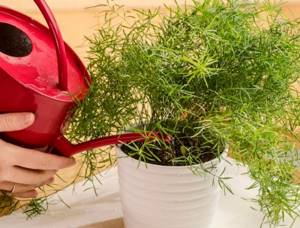
During active growth, indoor asparagus is provided with abundant regular watering. The soil mixture in the pot is moistened immediately after its top layer dries. In the autumn-winter period, watering is carried out only a couple of days after the top layer of the substrate in the pot has dried. Make sure that there is no drying out of the lump of earth in the pot or stagnation of liquid in it. It is recommended to water asparagus through a tray. To do this, pour the required amount of water into the pan, and after 30 minutes. from it they pour out what the earth mixture did not absorb.
Air humidity
When growing asparagus indoors, it is recommended to systematically moisten it with a sprayer, especially if the room is too hot. The best time to moisten the bush is early morning or evening (shortly before sunset). You can increase air humidity by pouring moistened sphagnum or expanded clay into a tray and placing a container with a plant on it, while moistening from a spray bottle is also carried out regularly.
Bloom
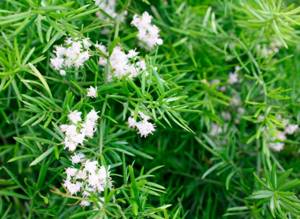
In order for asparagus grown indoors to bloom, you need to try hard. But if it begins to bloom, then inflorescences consisting of small white flowers will grow on the tops of its stems. If desired, carry out artificial pollination; to do this, take pollen from one flower with a soft brush and carefully move it to another. The fruit is a berry that is colored deep red.
Trimming
Asparagus is pruned in early spring when the bush is replanted. To do this, cut off all leafless stems that are already very old, thanks to this the growth of young shoots improves.
Fertilizer
This plant should be fed all year round. In winter, fertilizing is carried out once every 4 weeks, in the autumn months - once every half month, and in the spring-summer period, the frequency of fertilizing is increased to once every 7 days. For this purpose, mineral complex fertilizers are used, and they can be alternated with organic matter. The finished nutrient mixture should be of very low concentration.
Transplanting asparagus
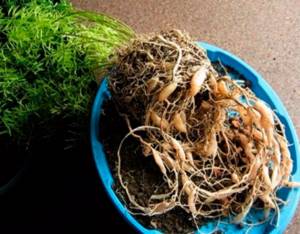
A young bush, before it turns 4 or 5 years old, is transplanted once a year in the spring. An older plant needs to be replanted less frequently, namely, once every 2 or 3 years. It is necessary to replant asparagus so often because its root system is characterized by very rapid growth. In this regard, when replanting, it is necessary to take a pot that is slightly larger than the old one, and the roots should be slightly trimmed.
Be sure to add a good layer of drainage to the bottom of the pot using expanded clay, this will prevent liquid from stagnating in the substrate. A suitable soil mixture should consist of humus and leaf soil, as well as sand (2:2:1). If desired, you can also add 2 parts of turf soil to this soil mixture. The transplanted bush is well watered, and after 7 days the first feeding is carried out.
Asparagus. Transfer.
Virulence
If asparagus flowers are manually pollinated during flowering, then red berries that contain poison can be formed. Under no circumstances should they be eaten. Those who have pets or children should pay special attention to this.
Kinds
There are many types of asparagus, but flower growers highlight some of them that are ideal for landscape design and home decoration .
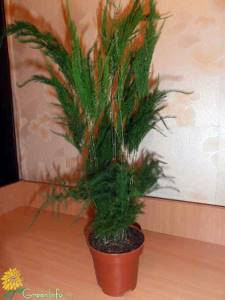
Asparagus pinnate (setaceus) can be found in the halls of schools, banks, and they decorate terraces and winter gardens. This species includes subshrubs with hairless and branching shoots. The leaves look like small triangular scales. In an adult plant older than 10 years, mostly paired white flowers appear, but single small flowers are also found. Asparagus pinnately needs light soil and timely watering. The flower grows in low light and at a temperature of +15 °C.- Meyer's asparagus can be grown both in the garden and as a houseplant. The bushes reach just over 50 cm in height. The branches are straight and even, but can bend under their own weight. Small side shoots extend from the central stems, making Meyer's asparagus look like a foxtail ovary. Very often this type is used to decorate bouquets. It is grown in wide containers; moisture stagnation is not allowed.
- Sprenger's asparagus is mainly grown as a hanging tree. It has long, weak stems, the length of which sometimes exceeds one and a half meters. The plant looks very beautiful when red berries appear after flowering. But only mature plants bloom. This species requires good lighting. In the shade, the branches will stretch out, fade, and all decorativeness will be lost.
- Crescent asparagus is often used in landscape design. Its emerald color perfectly sets off the greenery of other plants. It differs from other species in its long and thick shoots, the length of which in the wild reaches 15 meters.
- Asparagus Mix is a set of several plant species. By purchasing such a set, you will be able to evaluate the decorative qualities of different types and easily decide which one you like.
Reproduction methods
Growing from seeds
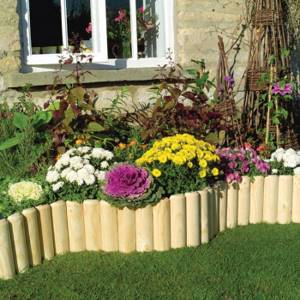
If asparagus grown indoors blooms, it may produce fruits and seeds, but only if you artificially pollinate the flowers. It is recommended to sow seeds immediately after collection (from January to March).
Fill the container with a substrate consisting of peat and sand (1:1). It is moistened, after which asparagus seeds are sown. The crops are covered with film (glass) on top and moved to a well-lit windowsill. As soon as condensation forms on the surface of the shelter, it should be opened briefly. Do not forget to spray the substrate with a spray bottle in a timely manner; the optimal air temperature for seed germination is about 22 degrees. The first seedlings should appear after 25–30 days. When the height of young plants is 10 centimeters, they should be picked. Seedlings are planted in separate containers in the first weeks of summer; for this, an earth mixture is used, consisting of humus, leaf and turf soil, as well as peat and sand, which are taken in equal parts. Then they are cared for in the same way as adult bushes.
Cuttings
Indoor asparagus cuttings are harvested in early spring by cutting several stems from the bush. The optimal length of cuttings is from 8 to 12 centimeters. For rooting, they are planted in a container filled with sand. Transfer the cuttings, covered with film (glass), to a well-lit place and provide them with a temperature of about 21–22 degrees. Don’t forget to water them promptly and ventilate them. If everything is done correctly, then they should take root in 4-6 weeks. After the young bushes grow a little, they are transplanted into separate pots, which are filled with soil mixture for adult plants.
Dividing the bush
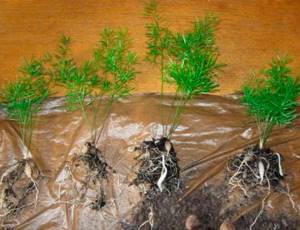
Depending on the size of the bush, it can be divided into 2, 3 or 4 parts during transplantation. Each of the divisions must be planted in an individual pot filled with the soil mixture used during asparagus transplantation (see above). If necessary, lightly trim the roots of the divisions.
Asparagus pinnate
The most delicate delicate greenery in the form of needles resembles a veil. Everything about this plant is elegant, thin needles, numerous branches creating a cascading flow. Caring for feathery asparagus is easy.
It must be remembered that it does not tolerate sunlight and immediately becomes stained. The plant needs to be sprayed and watered frequently. This variety is demanding on the soil; it must be prepared on the basis of peat, be light and sour. The best composition of the substrate for transplantation, made up of equal parts:
- peat;
- sand;
- leaf and turf soil;
The plant is used in landscaping office and residential premises, but it has no place in the bedroom, like other liana-like plants. Cirrus asparagus reproduces by planting, dividing rhizomes, and grows quickly. Asparagus plumosus Nanus is most suitable for indoor gardening. Overdrying the plant will lead to its death.
Diseases and pests
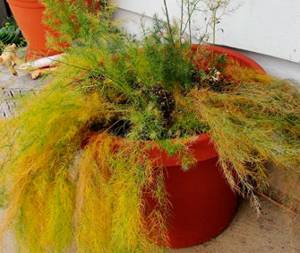
If asparagus is not properly cared for or grown in unsuitable conditions, then the following problems may arise with it:
- After cutting, the asparagus stalks stopped growing . Cut stems will not grow again, this is the peculiarity of this plant. However, after some time, young shoots will begin to actively grow.
- Spots appeared on the foliage . The plant reacts extremely negatively to direct sunlight. Because of them, spots may appear on the surface of the foliage, which are sunburn. And because of this, yellowing of the edges of the leaf plates may begin, and the foliage may also begin to fly off.
- Fall of leaves . In addition to the fact that leaves can fall due to too intense lighting, this can also happen due to excessively dry air in the room. The bush can also shed its leaves if it grows in too dark a place.
- Harmful insects . Spider mites most often live on asparagus. Experts advise, if possible, to use folk remedies to combat the pest, because the plant reacts extremely negatively to spraying with chemicals.
Meyer's asparagus
Mayer's asparagus is particularly compact and beautiful with its candle-shaped panicles. Each shoot individually resembles a dish brush. The plant produces such “candles” more than half a meter long, grows very quickly and requires annual spring replanting. This plant does not like pruning. It can be propagated by dividing the bush and by seeds. Compared to pinnate, Meyer's asparagus is unpretentious, tolerates temporary drought, but does not tolerate insecticides. Therefore, it is possible to destroy pests on it only with folk remedies.
Types of asparagus with photos and names
Asparagus racemosus
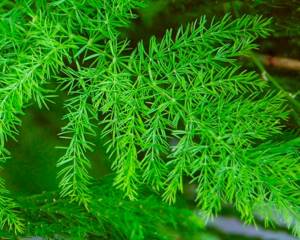
The length of the stems of this species is about 200 cm. Modified shoots (cladodes) grow in clusters of several pieces. Flowers collected in brushes have a pleasant smell.
Asparagus medeoloides

This species has straight and highly branched shoots. Under natural conditions, the bush can grow quite large.
Meyer's asparagus (Asparagus meyeri)
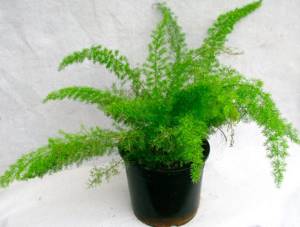
This species is represented by shrubs. It differs from most other species in that there is pubescence on the surface of its half-meter-long stems. The stems are decorated with densely arranged needles. This type is widely used to decorate cut bouquets, and they are also used in making compositions of fresh flowers.
Common asparagus (Asparagus officinalis)
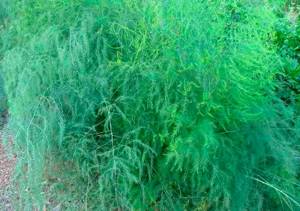
Either pharmaceutical asparagus or medicinal asparagus. This species is represented by herbaceous perennial plants. There is no pubescence on the surface of straight stems one and a half meters high. Straight branches grow at a slight angle or strictly vertically. Narrow thread-like cladodes, growing at an angle, directed along the trunk or upward, their length is about 30 mm. Like other species, the foliage of this asparagus is scaly. Both male and female yellowish-white flowers can grow on one bush at once. The length of male flowers is about 50 mm, and female flowers are a couple of times smaller. The fruit is a red, round berry.
Asparagus plumosus
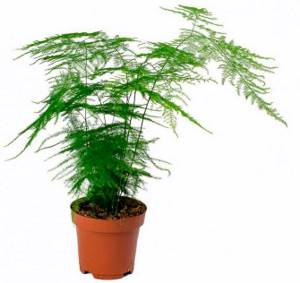
Or bristly asparagus (Asparagus setaceus). The species is naturally found in subtropical and tropical regions in eastern and southern Africa. This subshrub has branching smooth stems. Triangular scales are located on small leaf plates. Greenish modified stems (phyllocladia) grow in several pieces; they have a curved shape. The length of such stems is about 15 mm, and the width is up to 0.5 mm. Small white flowers can be single or grow in groups. The bluish-black fruits contain no more than three seeds. This species does not bloom at home. The most popular among gardeners is the dwarf pinnate asparagus.
Crescent asparagus (Asparagus falcatus)
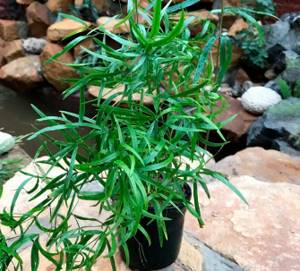
This species has the longest stems (about 15 meters), and they are also the thickest (up to 10 mm), but the bush can only reach such dimensions in natural conditions. Even asparagus cultivated in greenhouse conditions will not grow more than 4 meters in length. On the shoots that extend from the rhizome, crescent-shaped cladodes grow, the length of which is about 80 mm, their edge is corrugated. White, pleasantly smelling flowers are collected in small inflorescences.
Asparagus asparagoides
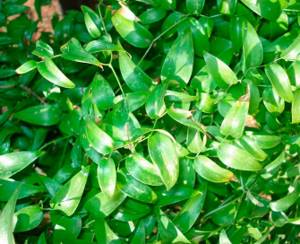
The species is native to South Africa. It is cultivated on a support or as an hanging plant. The color of the smooth stems is greenish. Glossy thin greenish shoots, leaf-shaped, ovoid. The small flowers are painted white; as a rule, the species does not bloom at home. The aroma of orange-red fruits is very similar to orange.
Asparagus benuissimus
Externally, the appearance is similar to pinnate asparagus. But this species has taller shoots (about one and a half meters), and their phyllocladies are also longer and narrower, and they do not grow very densely.
Sprenger's Asparagus (Asparagus sprengeri)
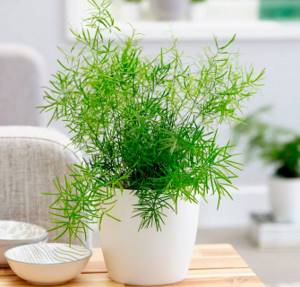
Either asparagus densiflorus or Ethiopian asparagus (Asparagus aethiopicus). The stems of this herbaceous perennial plant are weak and long (up to one and a half meters). There is no pubescence on their surface, but it can be either smooth or furrowed. The foliage consists of scales ranging from 20 to 40 mm long. Three-centimeter phyllocladia can grow one at a time or in groups of 2–4, they can be straight or curved. White or pink flowers smell very pleasant. Red berries contain one seed.
Asparagus pinnate, maintenance and care.
Types suitable for home and their photos
There are more than 200 species of this perennial plant, but only a few of them are suitable for growing at home.
Feathery or bristle-like (Asparagus plumosus)
It has soft central shoots and a slight bend, giving it a particularly decorative appearance. The leaves reach a length of 0.5 cm; thread-like branches about 1.5 cm in length develop in their axils. The side shoots are located horizontally.
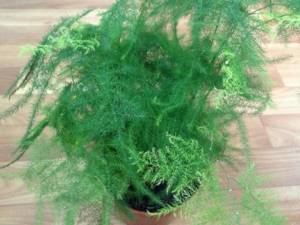
Sprenger or densely flowered (A. sprengeri)
The stems of the plant are bare, reach a length of up to 1.5 m, and are covered with scale-like leaves. It has round, red fruits and pink or white fragrant flowers bloom during flowering.
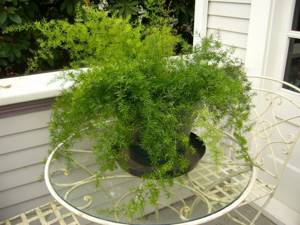
Meyer (A. meyeri)
On the shoots, reaching a length of 70-80 cm, there are many leaves resembling needles. It has small white flowers and small red fruits.
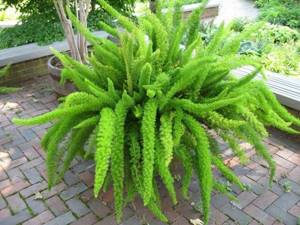
Crescent (A. falcatus)
It has lignified stems covered with thorns and shoots up to 4 m long. During flowering, cream flowers form racemose inflorescences.
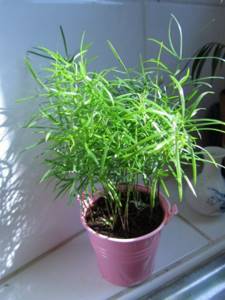
Asparagus (A. asparagoides)
It has ovoid shoots of light green color, fruits of red-orange color with the smell of oranges.
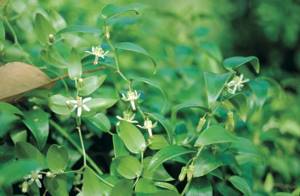
What is asparagus: description and types
Asparagus are called perennials of the asparagus family. The species composition, numbering about 300 representatives, includes subshrubs, vines and herbs.
Asparagus cultivation began in the Mediterranean about 5,000 years ago. In the 18th century it was brought to Russia. Due to its high cost, the product received the popular name “master’s vegetable.”
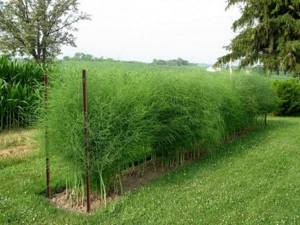
Common asparagus
Asparagus grows wild, is cultivated as a vegetable crop, and is grown for ornamental purposes.
Variety of species
Among the plants used for culinary and medicinal purposes, the following types are common:
- medicinal asparagus or common asparagus (asparagus officinalis);
- white asparagus;
- green asparagus;
- asparagus asparagus (asparagus asparagoides).
Vitamin C, nicotinic and chelidonic acid, thiamine, saponins, coumarins, essential oils, amino acids, and potassium contained in medicinal asparagus make the product useful in the treatment of diseases of the respiratory and urinary systems. Asparagus extracts can lower blood pressure. Infusions from the greenery of the asparagus vulgaris plant are used in the fight against dandruff and hair loss.
Thanks to the fiber, antioxidants and microelements contained in asparagus, the plant has become a useful ingredient in side dishes and salads.
Interesting! The delicate needles and bright fruits of medicinal asparagus make it possible to use it in floristry and landscape design.
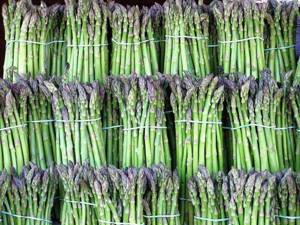
Asparagus shoots
On store shelves you can find the so-called “Korean asparagus”. The name may lead the buyer to think that it is asparagus. In fact, the product has nothing in common with the asparagus family, because is a semi-finished soybean product (fuju).
Among the variety of asparagus, decorative species are widely represented. The following asparagus plants decorate garden plots and home interiors:
- feathery (plumosus) or bristly (setaceus);
- asparagus (asparagoides);
- Sprenger (sprengeri);
- medeoloides;
- racemosus;
- sickle-shaped (falcatus);
- Meyer (meyeri);
- subtlest (benuissimus).
Living in an apartment is suitable for a large number of representatives of the asparagus family, which is why asparagus is popular among flower growers.
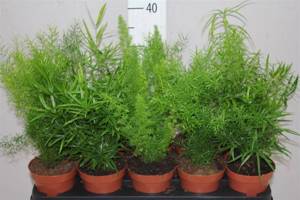
Potted plants
Questions that arise when growing a flower
If you do not follow the basic rules of caring for the plant, asparagus may lose its rich green color, thin out or die.
What to do if asparagus turns yellow and crumbles
This problem occurs for the following reasons:
- lack of moisture and exposure to direct sunlight (leaves have brown spots from burns);
- high temperature and lack of light (if there are no signs of burns);
- frequent drafts;
- overgrown root system.
You should rearrange the plant, replant it if necessary, create an optimal temperature regime and take care of proper watering.
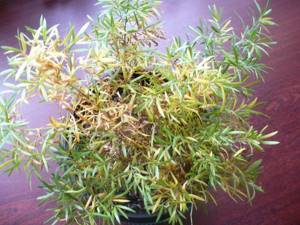
Yellowed leaves
Why does the plant shed buds and leaves?
This problem may be caused by:
- lack of nutrients;
- the action of pests;
- inappropriate temperature, humidity, lack or excess of light.
Lack of nitrogen and iron forces asparagus to “get rid” of its foliage. For greenery to grow and buds to form, it is necessary to feed the flower.
Pests should be controlled in a timely manner. Spider mites, aphids, waxbugs and scale insects can cause irreparable damage, including the death of the flower.
Important! “Ambulance” for getting rid of pests is the drug “Actellik”. A bottle (2 ml.) dissolves in 1 liter. water and sprayed onto the stems and leaves of the plant. Treatment is carried out twice with an interval of 5-7 days.
